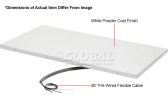Hi everyone. We have a Russian tortoise who is 20 and have had difficulty heating her tortoise table over the years because of its location. We recently tried some new changes, particularly low-power heaters which you can build yourself and wanted to share in the information in case anyone else has had similar issues or can use the information. While the video primarily deals with heating issues, based on posts I've read on the forum, there might be objections to other care decisions shown in the video such as using orchard grass and coil UV bulbs. Just wanted to let you know that our tortoise vet actually recommended the orchard grass (as we have an older tortoise) and we measure the UV with a Solarmeter (index is consistent 5-6 right underneath, 3-4 within a foot or so, and 1-2 about two feet out). We used to use a 24" tube bulb but had a problem in that we were replacing the bulb every six months but the ballast was going and we couldn't tell. So, finally got an index meter (agree with everyone on the forum that this is well worth the investment) and found the problem. We couldn't find a reliable replacement ballast so switched to the coil bulbs. Not sure about their reliability but time will tell.
Anyway, here is a link to the video in case anyone might want to try experimenting with building low-power, direct current heaters:
As a side note to the video, you can build higher wattage heaters if your enclosure needs it as the Peltier modules come in a variety of ratings.
Anyway, here is a link to the video in case anyone might want to try experimenting with building low-power, direct current heaters:
As a side note to the video, you can build higher wattage heaters if your enclosure needs it as the Peltier modules come in a variety of ratings.
